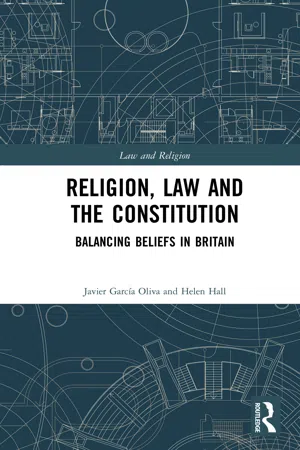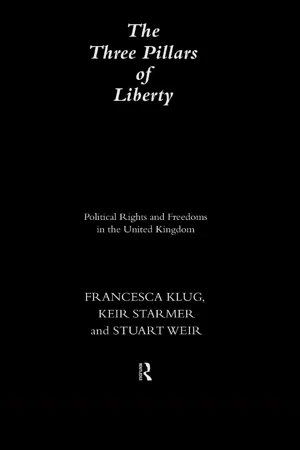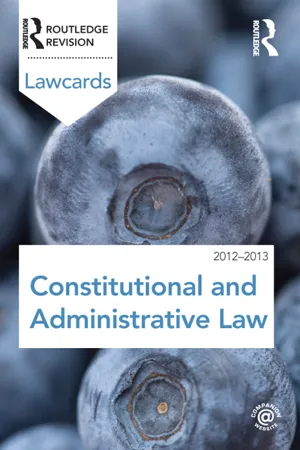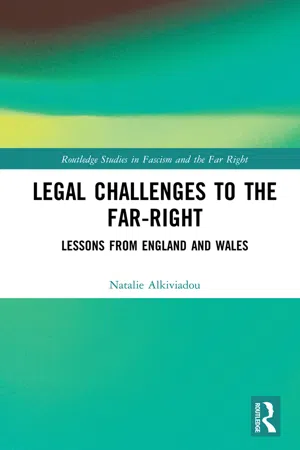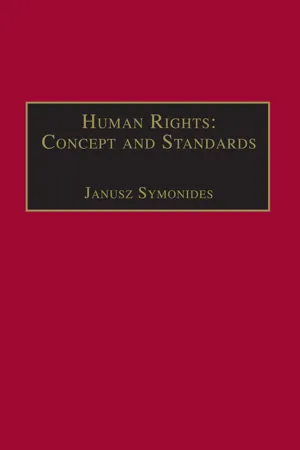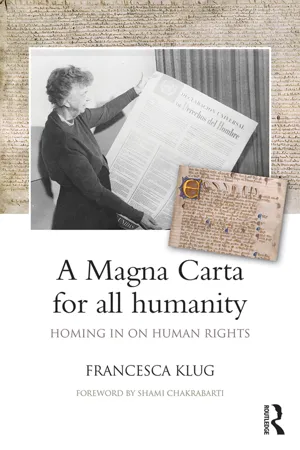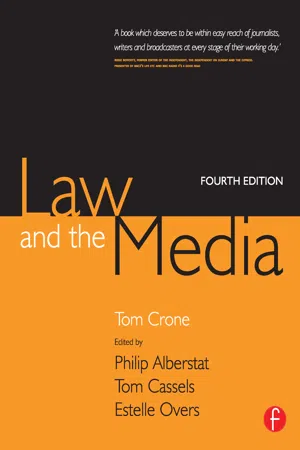Law
Human Rights in UK
Human rights in the UK refer to the fundamental freedoms and protections afforded to individuals under UK law and international human rights conventions. These rights encompass civil, political, economic, social, and cultural rights, and are upheld and enforced by various legal mechanisms and institutions. The UK has incorporated human rights principles into its legal framework through legislation such as the Human Rights Act 1998.
Written by Perlego with AI-assistance
Related key terms
9 Key excerpts on "Human Rights in UK"
- eBook - ePub
Religion, Law and the Constitution
Balancing Beliefs in Britain
- Javier García Oliva, Helen Hall(Authors)
- 2017(Publication Date)
- Routledge(Publisher)
Different narratives following a broadly similar trajectory can be traced in relation to other legally and culturally disempowered groups in society – for example, children, racial minorities, religious minorities, the mentally incapacitated, homosexual and transgender citizens, as well as the economically disadvantaged. This is not to downplay the profound and continuing differences, as each group has its own story, has faced and continues to face its own challenges. Furthermore, we certainly do not imply that inequality is something which we have successfully consigned to history, but the legal system has transitioned to a position in which human rights are accepted as being exactly that: rights vested in human beings by virtue of their humanity.7.2.2.2 Recognition of human rights in the United KingdomJust as the number of citizens in possession of legal rights evolved over time, so there is an increase in the number of rights. There are now more diners at the table, and the menu has vastly expanded. Nevertheless, despite the journalistic hype cited above, it would be absurd to suggest that human rights had no place within the United Kingdom legal framework until the Human Rights Act was passed by the Blair administration.In the following brief overview we shall consider: (i) human rights conferred by the United Kingdom legal framework before 1998; (ii) the significance of second and third generation rights; and (iii) the European Convention on Human Rights.7.2.2.2.1 HUMAN RIGHTS CONFERRED BY THE UNITED KINGDOM LEGAL FRAMEWORK PRIOR TO 2000As has already been discussed, human rights are ancient in origin, but there are a number of significant legal developments which enshrine certain specific rights within the law of the United Kingdom.Although it has been accorded talismanic status, the rights conferred by the Magna Carta were very much the stuff of reality as well as legend in the sense that they have functioned to shape legal thinking. Clause 29 remains part of British law: - eBook - ePub
The Three Pillars of Liberty
Political Rights and Freedoms in the United Kingdom
- Francesca Klug, Keir Starmer, Stuart Weir(Authors)
- 2003(Publication Date)
- Routledge(Publisher)
PART 2 The UK Framework for Protecting Rights Introduction The Three Pillars of Liberty The system The United Kingdom possesses no ‘system’ for protecting human rights in the sense of a specific political and legal structure designed for that purpose. There is no fundamental constitutional law nor fundamental rights enjoying special constitutional and legal protection against interference by Parliament or the courts. Even the idea of a ‘system’ seems alien to a tradition of civil liberties which is seen to have grown organically. Thus, what has come to be understood as the ‘system’ for protecting human rights in this country is a set of constitutional arrangements which, whatever their historic purpose, protect human rights in practice. These arrangements differ from those found in most other countries, where the rights of individual citizens are usually set out in broad terms in a Bill of Rights or other constitutional document. The United Kingdom has no Bill of Rights of this kind. The 1688 Bill of Rights and the Claim of Right of 1689 (its Scottish equivalent) contain some important clauses designed to safeguard personal liberty. But they are essentially declarations about the relationship between Parliament and the Crown. Human rights are protected by the ordinary law of the land—a diversity of specific rights are established by a combination of the common law and express Acts of Parliament, each with an accompanying remedy. Thus, to secure an individual’s freedom from unlawful or arbitrary detention, the law provides specific and detailed remedies such as habeas corpus and an action in damages for false imprisonment. Unusually, the law makes no fundamental distinction between ‘public law’, governing acts of the state and its agents, and ‘private law’, regulating the relations between private citizens (at least as regards rights and remedies) - Routledge(Author)
- 2013(Publication Date)
- Routledge(Publisher)
5Human rights and civil liberties
The historical protection of fundamental rights and liberties The nature of residual rights and its contemporary relevance in the UK The role and function of the European Convention on Human Rights The Human Rights Act 1998 and the arrival of positive rights How to raise Convention rights under the Human Rights Act 1998 The scope of rights restricted by statute and the common lawIn Chapter 1 constitutional law was described as being concerned with the role and powers of state institutions and with the relationship between the citizen and the state. In this chapter we examine the relationship between the individual and the state, in particular the protections given by the common law and statute to the freedoms and liberties of the individual within the state. The entire landscape of this relationship has been crucially changed by the Human Rights Act (HRA) 1998 . We will examine the Act and its impact in some detail here, but for a full study guide the student is referred to the comprehensive Lawcard on Human Rights (2010).HISTORICAL BASIS FOR THE PROTECTION OF FUNDAMENTAL RIGHTS AND LIBERTIES
Historically, the protection of an individual’s fundamental rights and liberties in the UK, like the constitution itself, has lacked the certainty of a written declaration such as might be found in a comprehensive Bill of Rights. Apart from the protections provided by the four great statutes enacted to regulate the relations between the Crown and people – the Magna Carta of Edward I (1297) , the Petition of Right (1627) , the Bill of Rights (1689) , and the Act of Settlement (1700) – containing general provisions to ensure the peaceful enjoyment of one’s property, as well as freedom from illegal detention, duress, punishment or taxation, and apart from specific legislation conferring particular rights, the rights and liberties of the individual in the UK are not expressly defined in any distinct law or code. The changes to this position brought about by the enactment of the HRA 1998- eBook - ePub
Legal Challenges to the Far-Right
Lessons from England and Wales
- Natalie Alkiviadou(Author)
- 2019(Publication Date)
- Routledge(Publisher)
Human rights and fundamental freedomsIn view of the fact that the issues set out within this book are assessed through a human rights lens, this chapter looks at the human rights framework of the country as this will facilitate the subsequent discussion. To this end, this chapter pinpoints how the key freedoms of non-discrimination, expression, assembly and association are established in domestic law. By conceptualising and contextualising human rights protection in England and Wales, the reader will be better able to follow the philosophy behind, for example, restrictions to rights and freedoms if these are sought for far-right purposes.Freedom of expression
Even before the incorporation of the Human Rights Act 1998 (HRA), the freedom of expression was anyhow constructed and protected in the common law framework.1 However, the fact remains that there was no statutory protection of the right to the freedom of expression up until the passing of the HRA in 2000. That was the first time that the meaning of the freedom of expression and a reference to the limitations that can be legitimately imposed thereto, as so provided by Article 10 of the European Convention on Human Rights (ECHR), were incorporated into national legislation. In fact, referring to two cases, namely R v Secretary of State for the Home Department2 and Reynolds v Times Newspapers Ltd,3 one commentator noted that an embracement of the freedom of expression by the courts can be discerned during the time when the HRA was being passed.4 For example, in the former case, which dealt with prisoners’ freedom of expression, the House of Lords deemed this freedom to be ‘as strongly protected in the common law as it is under the Convention’.5 In the latter case on defamation and libel, Lord Steyn, in citing the 1972 case of Broome v Cassell & Co. Ltd,6 noted that there is a ‘constitutional right to freedom of expression in England’.7 - Richard Johnson, Yuan Yi Zhu, Richard Johnson, Yuan Yi Zhu(Authors)
- 2023(Publication Date)
- Hart Publishing(Publisher)
14 Something important has been lost in our understanding of rights. The requirements of justice may demand greater nuance in our thinking and more active effort on the part of Parliament than has currently been given. Judicial protection of genuinely fundamental rights has long been an aspect of the common law, with courts interpreting statute and common law rule to conform to the rule of law and its related fundamental principles. But this has always needed to be supplemented by legislative choice from within the realm of reasonable disagreement.Fundamental rights are the floor below which no rule-of-law-compliant system can fall, but a society directed towards the flourishing of its members will obviously go beyond that. The court’s role vis-à-vis Parliament and the executive, from Coke to Dicey, has been understood to police the outermost limits of reason so that statute and the related limits on executive action are interpreted in ‘the spirit of legality’.15 What has changed with the enactment of the Human Rights Act is the way in which we identify the scope and content of rights, moving from the particular under classic common law to the exceptionally general, purposively vague, under modern human rights law.Classic common law rights were first identified by reference to common law duties. While it is correct to say, as a matter of analytical philosophy, that rights and duties are correlatively entailed,16 in practice, it matters doctrinally which grounds the other for the purposes of identification. Common law courts, within constitutional and administrative law, have historically identified the limits on the authority of public officials and only derivatively concerned themselves with the entailed rights of claimants, where they require such rights at all. For example, the ancient writ of habeas corpus is a remedy through which the lawfulness of a detention could be tested; it is not a general right to liberty. As a ‘great and efficacious writ in all manner of illegal confinement’,17- eBook - ePub
- Janusz Symonides(Author)
- 2017(Publication Date)
- Routledge(Publisher)
There is no guarantee for any international human rights that they will be treated as legal rights in domestic law, but some are more easily accepted than others. This, however, also depends on the political and cultural system of the society concerned. The overall purpose of the International Bill of Human Rights is to promote their acceptance within all domestic systems and, as far as possible, also to make them into legal rights within domestic systems. However, not all international human rights lend themselves easily to being made justiciable in domestic systems, nor is it obvious that all aspects should be justiciable.With regard specifically to economic and social rights, some elements can be made more easily justiciable than others. First, those aspects which deal with freedom from the state are, at least in Western societies, the elements which are most easily made into enforceable legal rights. The right to peaceful possession of property and the right to freedom from forced labour are among the most obvious examples. Of much greater significance is the application of the principle of non-discrimination. It may be uncertain how far a state is obliged to go in developing a system of social security. Where the right to social security is not immediately a subjective legal right, unless appropriate domestic legal legislation has been adopted, it becomes a legal right as soon as a state starts adopting such legislation, since it will then have to respect the principle of non-discrimination. Consequently, for every step a state wants to take, possibly based on purely pragmatic reasons relating to domestic needs, in developing social rights, it will have to apply these rights equally even if the domestic law itself is restrictive. On the basis of international human rights law, a justiciable legal right can emerge for the individual. This has tremendous significance, and is the most formidable platform on which the economic and social rights edifice can be gradually built up at the domestic level. Second, there are certain economic and social rights which can be seen as minimum rights that should be available to everyone and, on that basis, objective individual rights might emerge. The right to primary education free of charge is in the process of becoming such a basic right, and may already be considered a subjective right for every individual, whether this be based on customary international law or on treaty law. - eBook - ePub
A Magna Carta for all Humanity
Homing in on Human Rights
- Francesca Klug(Author)
- 2015(Publication Date)
- Routledge(Publisher)
73 beyond domestic or international laws to protect civil liberties. Even Liberty only started to describe itself as a human rights organization in this period.No one marched on Whitehall demanding a bill of rights based on universal values, of course, but the developing language of human rights came to capture one of the mini zeitgeists of the time. This was observed by Baroness Helena Kennedy, QC, the highly respected human rights lawyer, in the forward to my book, Values for a Godless Age , published to coincide with the introduction of the HRA in 2000:Human rights is becoming the language of diplomacy and peace-keeping and the sea change is being felt not only internationally but in our domestic jurisdictions.74All these factors provided the broad context in which thousands of Charter 88 signatories called for a raft of reforms, including a bill of rights. In return the government kept repeating how free everyone was.75 The Labour-supporting think tank the Institute of Public Policy Research (IPPR) established a committee of experts to draft a prototype British bill of rights, led by Anthony Lester QC, that would allow the courts to overturn Acts of Parliament as part of a written constitution.76 The Scottish Council for Civil Liberties and the Committee for the Administration of Justice produced their own proposals for a judicially entrenched bill of rights for Scotland and Northern Ireland, respectively.77By this time momentum was building in favour of introducing a bill of rights through incorporating the ECHR into UK law amongst the senior judiciary. Lawyers schooled in the English common law, whose predecessors quivered at the Convention’s broad and purposive language a generation previously, were now openly lamenting that they were constitutionally barred from importing ECHR norms into UK law. Whilst there was some pressure to incorporate ‘through the back door’, due to the recent practice of a new generation of judges beginning to import Strasbourg jurisprudence into their judgments where they could, this was a stunted endeavour.78 In research for a Democratic Audit project with Keir Starmer and Stuart Weir, based at Essex University, we found that up until 1995 there were only 172 cases where domestic judges had cited the ECHR at all.79 A correlation was drawn between the UK being one of a very few countries in the Council of Europe not to have incorporated the ECHR into domestic law in some form, and reaching the top of the league of adverse judgments before the ECtHR, although the total number was still very small.80 - eBook - ePub
- Tom Crone, Tom Cassels, Estelle Overs(Authors)
- 2013(Publication Date)
- Routledge(Publisher)
VIII The Law under the European Convention on Human RightsPassage contains an image
19 The Human Rights Act 1998
Hugh Tomlinson QC DOI: 10.4324/9780080496030-3119.1 Introduction
The Human Rights Act 1998 (the ‘HRA’) came into effect on 2 October 2000. It is designed to ‘give further effect’ to the rights and freedoms enshrined in the European Convention on Human Rights (the ‘Convention’) and to make them enforceable in the courts of the United Kingdom. It is now unlawful for ‘public authorities’, including courts, to act in a way that is incompatible with Convention rights. A number of these rights, including the right to freedom of expression (Article 10) and the right to respect for private life (Article 8), are of particular importance for the media. The law of defamation is potentially subject to substantial change as a result of the HRA. In addition, the HRA is likely to lead to further significant revisions of the principles governing court reporting and the development of a tort of invasion of privacy.19.2 The basic scheme of the Human Rights Act 1998
19.2.1 General principles
The Convention is an international treaty, under the terms of which the United Kingdom is bound to secure to everyone within its jurisdiction the rights and freedoms that are set out (Article 1 of the Convention). It was designed, in the aftermath of the Second World War, to protect the individual against State interference with their fundamental rights and freedoms. Although the United Kingdom accepted the right to individual petition under the Convention in 1966, the Convention was not enforceable in the English courts.The HRA was designed to ‘give further effect’ to the Convention without disturbing the sovereignty of Parliament. The HRA does not directly incorporate the Convention into English law, but gives effect to it by requirements relating to the interpretation of legislation and the actions of public authorities. - Austen Garwood-Gowers, John Tingle, Tom Lewis(Authors)
- 2013(Publication Date)
- Routledge-Cavendish(Publisher)
CHAPTER 2THE HUMAN RIGHTS ACT 1998 AND THE COMMON LAW, A HEALTHCARE LAW PERSPECTIVE
John HodgsonCOMMON LAW RULES AND THE EUROPEAN CONVENTION
When the European Convention on Human Rights (ECHR) was drafted in 1949–50, the focus was on human rights writ large. It was part of the general post-war settlement, and was initially conceived as a regional version of the Universal Declaration of Human Rights.1 It was not until a late stage in the travaux préparatoires that a draft tabled by the UK delegation actually produced an enforcement mechanism.2 Even so the Preamble clearly indicates the relationship with the Universal Declaration:The governments signatory hereto, being members of the Council of Europe Considering the Universal Declaration of Human Rights proclaimed by the General Assembly of the United Nations on 10 December 1948; Considering that this Declaration aims at securing the universal and effective recognition and observance of the Rights therein declared;Considering that the aim of the Council of Europe is the achievement of greater unity between its members and that one of the methods by which that aim is to be pursued is the maintenance and further realisation of human rights and fundamental freedoms;Reaffirming their profound belief in those fundamental freedoms which are the foundation of justice and peace in the world and are best maintained on the one hand by an effective political democracy and on the other by a common understanding and observance of the human rights upon which they depend;Being resolved, as the governments of European countries which are likeminded and have a common heritage of political traditions, ideals, freedom and the rule of law, to take the first steps for the collective enforcement of certain of the rights stated in the Universal Declaration.While there is a specific guarantee of ‘due process’ in Art 5 (relating to the deprivation of liberty) and Art 6 (relating to trial), it is clear that these were specifically aimed at preventing a repetition of the arbitrary arrests of the GeStapo and other Nazi bodies and the mockery of legality in Freisler’s Volksgericht, with obvious reference to similar abuses in the remaining dictatorships of the left and right in Europe at the time.
Learn about this page
Index pages curate the most relevant extracts from our library of academic textbooks. They’ve been created using an in-house natural language model (NLM), each adding context and meaning to key research topics.
